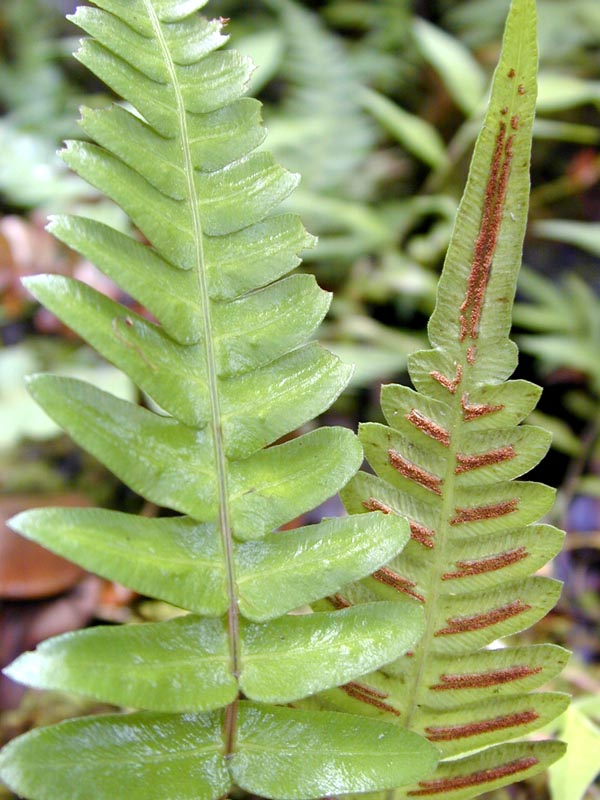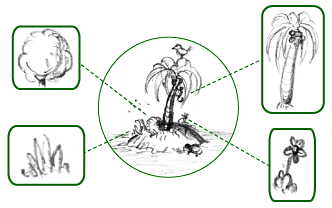|
Picramnia Xalapensis
''Picramnia xalapensis'' is a plant species native to the State of Veracruz, Mexico. Type locale is in the mountains near the City of Xalapa. ''Picramnia xalapensis'' is a shrub to small tree. Leaves are evergreen, thick, leathery, pinnately Pinnation (also called pennation) is the arrangement of feather-like or multi-divided features arising from both sides of a common axis. Pinnation occurs in biological morphology, in crystals, such as some forms of ice or metal crystals, and in ... compound, lacking stipules. Leaves are numerous, ovate to lanceolate, gradually tapering at the tip.Thomas, W. W. 1988. A conspectus of Mexican and Central American ''Picramnia'' ( Simaroubaceae). Brittonia 40(1): 89–105. References {{Taxonbar, from=Q16988085 Picramniales Flora of Veracruz Endemic flora of Mexico ... [...More Info...] [...Related Items...] OR: [Wikipedia] [Google] [Baidu] |
Jules Émile Planchon
Jules Émile Planchon (21 March 1823 – 1 April 1888) was a French botanist born in Ganges, Hérault. Biography After receiving his Doctorate of Science at the University of Montpellier in 1844, he worked for a while at the Royal Botanic Gardens, Kew, Royal Botanical Gardens in London, and for a few years was a teacher in Nancy, France, Nancy and Ghent. In 1853 he became head of the department of botanical sciences at the University of Montpellier, where he remained for the remainder of his career. Planchon was highly regarded in scientific circles, and made a number of contributions in his classification of botanical species and varieties. He is credited with publishing over 2000 botanical names, including ''Actinidia chinensis'', better known as the "golden kiwifruit". Planchon is remembered for his work in saving French grape vineyards from ''Phylloxera vastatrix'', a microscopic, yellow aphid-like pest that was an exotic species from the United States. He performed this ta ... [...More Info...] [...Related Items...] OR: [Wikipedia] [Google] [Baidu] |
Veracruz
Veracruz (), formally Veracruz de Ignacio de la Llave (), officially the Free and Sovereign State of Veracruz de Ignacio de la Llave ( es, Estado Libre y Soberano de Veracruz de Ignacio de la Llave), is one of the 31 states which, along with Mexico City, comprise the 32 Federal Entities of Mexico. It is located in eastern Mexico and is bordered by seven states, which are Tamaulipas, San Luis Potosí, Hidalgo, Puebla, Oaxaca, Chiapas, and Tabasco. Veracruz is divided into 212 municipalities, and its capital city is Xalapa-Enríquez. Veracruz has a significant share of the coastline of the Gulf of Mexico on the east of the state. The state is noted for its mixed ethnic and indigenous populations. Its cuisine reflects the many cultural influences that have come through the state because of the importance of the port of Veracruz. In addition to the capital city, the state's largest cities include Veracruz, Coatzacoalcos, Córdoba, Minatitlán, Poza Rica, Boca Del Río and Or ... [...More Info...] [...Related Items...] OR: [Wikipedia] [Google] [Baidu] |
Type (biology)
In biology, a type is a particular specimen (or in some cases a group of specimens) of an organism to which the scientific name of that organism is formally attached. In other words, a type is an example that serves to anchor or centralizes the defining features of that particular taxon. In older usage (pre-1900 in botany), a type was a taxon rather than a specimen. A taxon is a scientifically named grouping of organisms with other like organisms, a set that includes some organisms and excludes others, based on a detailed published description (for example a species description) and on the provision of type material, which is usually available to scientists for examination in a major museum research collection, or similar institution. Type specimen According to a precise set of rules laid down in the International Code of Zoological Nomenclature (ICZN) and the International Code of Nomenclature for algae, fungi, and plants (ICN), the scientific name of every taxon is almost al ... [...More Info...] [...Related Items...] OR: [Wikipedia] [Google] [Baidu] |
Xalapa
Xalapa or Jalapa (, ), officially Xalapa-Enríquez (), is the capital city of the Mexican state of Veracruz and the name of the surrounding municipality. In the 2005 census the city reported a population of 387,879 and the municipality of which it serves as municipal seat reported a population of 413,136. The municipality has an area of 118.45 km2. Xalapa lies near the geographic center of the state and is the second-largest city in the state after the city of Veracruz to the southeast. Etymology The name ''Xalapa'' comes from the Classical Nahuatl roots (, 'sand') and (, 'place of water'), which means approximately 'spring in the sand'. It's classically pronounced in Nahuatl, although the final /n/ is often omitted. This was adopted into Spanish as ''Xalapa''. The complete name of the city is ''Xalapa-Enríquez'', bestowed in honor of a governor from the 19th century, Juan de la Luz Enríquez. The city's nickname, "City of Flowers" ( es, La ciudad de las flores), was ... [...More Info...] [...Related Items...] OR: [Wikipedia] [Google] [Baidu] |
Pinnately
Pinnation (also called pennation) is the arrangement of feather-like or multi-divided features arising from both sides of a common axis. Pinnation occurs in biological morphology, in crystals, such as some forms of ice or metal crystals, and in patterns of erosion or stream beds. The term derives from the Latin word ''pinna'' meaning "feather", "wing", or "fin". A similar concept is "pectination," which is a comb-like arrangement of parts (arising from one side of an axis only). Pinnation is commonly referred to in contrast to "palmation," in which the parts or structures radiate out from a common point. The terms "pinnation" and "pennation" are cognate, and although they are sometimes used distinctly, there is no consistent difference in the meaning or usage of the two words.Jackson, Benjamin, Daydon; A Glossary of Botanic Terms with their Derivation and Accent; Published by Gerald Duckworth & Co. London, 4th ed 1928 Plants Botanically, pinnation is an arrangement of discre ... [...More Info...] [...Related Items...] OR: [Wikipedia] [Google] [Baidu] |
Stipule
In botany, a stipule is an outgrowth typically borne on both sides (sometimes on just one side) of the base of a leafstalk (the petiole). Stipules are considered part of the anatomy of the leaf of a typical flowering plant, although in many species they may be inconspicuous —or sometimes entirely absent, and the leaf is then termed ''exstipulate''. (In some older botanical writing, the term "stipule" was used more generally to refer to any small leaves or leaf-parts, notably prophylls.) The word ''stipule'' was coined by Linnaeus''Concise English Dictionary'' Wordsworth Editions Ltd. 1994, from Latin ''stipula'', straw, stalk. Types of stipules General characteristics The position of stipules on a plant varies widely from species to species, though they are often located near the base of a leaf. Stipules are most common on dicotyledons, where they appear in pairs alongside each leaf. Some monocotyledon plants display stipule-like structures, but only display one per leaf ... [...More Info...] [...Related Items...] OR: [Wikipedia] [Google] [Baidu] |
Simaroubaceae
The Simaroubaceae are a small, mostly tropical, family in the order Sapindales. In recent decades, it has been subject to much taxonomic debate, with several small families being split off. A molecular phylogeny of the family was published in 2007, greatly clarifying relationships within the family. Together with chemical characteristics such as the occurrence of petroselinic acid in ''Picrasma'', in contrast to other members of the family such as ''Ailanthus'', this indicates the existence of a subgroup in the family with ''Picrasma'', ''Holacantha'', and ''Castela''. The best-known species is the temperate Chinese tree-of-heaven ''Ailanthus altissima'', which has become a cosmopolitan weed tree of urban areas and wildlands. Well-known genera in the family include the tropical ''Quassia'' and ''Simarouba ''Simarouba'' is a genus of trees and shrubs in the family Simaroubaceae, native to the neotropics. It has been grouped in the subtribe Simaroubina along with the ''Simaba'' ... [...More Info...] [...Related Items...] OR: [Wikipedia] [Google] [Baidu] |
Picramniales
Picramniaceae is a small, mainly neotropical family of four genera '' Aenigmanu'', ''Alvaradoa'', ''Nothotalisia'' and ''Picramnia''. The family is the only member of the order Picramniales. Members of the family were formerly placed in the family Simaroubaceae or misidentified as species in the family Sapindaceae, in the order Sapindales. The most recent standard classification of the Angiosperms (the APG III system) distinguishes it as a separate family and order. It belongs to the malvids (eurosids II), one of the three groups that constitute the rosids. In 2021, a new genus was identified from materials collected almost 50 years prior. It was discovered by Robert Foster in 1973, but no scientist was able to identify it. It is named ''Aenigmanu'' for the enigma it originally presented to researchers. * Family Picramniaceae ** Genus '' Aenigmanu'' ** Genus ''Alvaradoa'' ** Genus ''Nothotalisia'' ** Genus ''Picramnia ''Picramnia'', the bitterbushes, is a genus of plant consi ... [...More Info...] [...Related Items...] OR: [Wikipedia] [Google] [Baidu] |
Flora Of Veracruz
Flora is all the plant life present in a particular region or time, generally the naturally occurring (indigenous) native plants. Sometimes bacteria and fungi are also referred to as flora, as in the terms '' gut flora'' or '' skin flora''. Etymology The word "flora" comes from the Latin name of Flora, the goddess of plants, flowers, and fertility in Roman mythology. The technical term "flora" is then derived from a metonymy of this goddess at the end of the sixteenth century. It was first used in poetry to denote the natural vegetation of an area, but soon also assumed the meaning of a work cataloguing such vegetation. Moreover, "Flora" was used to refer to the flowers of an artificial garden in the seventeenth century. The distinction between vegetation (the general appearance of a community) and flora (the taxonomic composition of a community) was first made by Jules Thurmann (1849). Prior to this, the two terms were used indiscriminately.Thurmann, J. (1849). ''Essai de ... [...More Info...] [...Related Items...] OR: [Wikipedia] [Google] [Baidu] |
.jpg)


